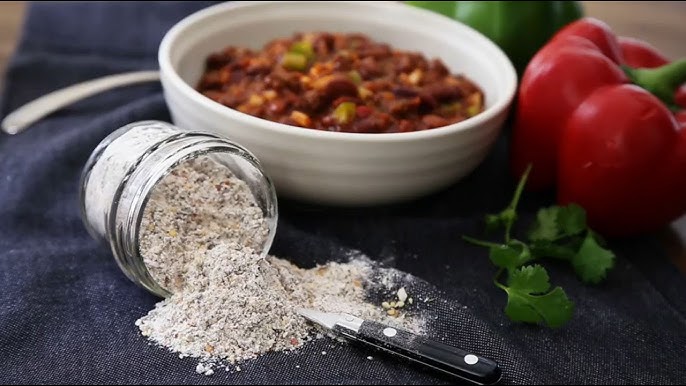Chilli Seasoning Recipe: If you’re a fan of bold, fiery flavors, then chilli seasoning deserves a permanent spot in your kitchen. Whether you’re whipping up a hearty pot of chilli, seasoning meats, or sprinkling over roasted veggies, this spice blend adds the perfect punch. Instead of relying on store-bought packets full of preservatives, you can easily prepare a homemade version that is fresher, healthier, and fully customizable.
This guide will walk you through the essential ingredients, step-by-step preparation, and expert tips to make your chilli seasoning stand out.
What is Chilli Seasoning?
Chilli seasoning is a spice blend created to add depth, warmth, and heat to dishes. Unlike plain chilli powder, which is usually ground dried chillies, chilli seasoning is a mix of multiple spices that balance heat, smokiness, and earthy tones. The classic version includes chilli powder, cumin, paprika, oregano, garlic powder, onion powder, and a touch of cayenne pepper. Together, these ingredients create a seasoning that transforms bland meals into bold, flavor-packed dishes.
Think of chilli seasoning as the foundation of Tex-Mex cooking. It not only enhances the taste of your food but also brings harmony among ingredients by layering different flavor notes. A spoonful can turn a simple pot of beans into a comforting dish or make grilled chicken irresistible.
Why Make Homemade Chilli Seasoning Instead of Store-Bought?
Store-bought seasoning packets often contain fillers, preservatives, and excess salt that reduce the quality of your meals. When you make chilli seasoning at home, you control every ingredient, ensuring freshness and balance. Plus, homemade blends are cost-effective—once you invest in the core spices, you can create large batches for months at a fraction of the price.
Another reason is flexibility. Love smoky flavors? Add more smoked paprika. Prefer a fiery kick? Increase cayenne or crushed red pepper flakes. Homemade chilli seasoning is about tailoring the blend to your taste preferences, making it unique to your kitchen.
And let’s be honest—nothing beats the aroma of freshly mixed spices. The moment you stir them together, your kitchen fills with warm, earthy scents that instantly spark cravings.
Ingredients You’ll Need for Chilli Seasoning
Core Spices for the Blend
A balanced chilli seasoning starts with a few key spices, each playing an essential role in flavor:
- Chilli Powder (2 tablespoons) – The heart of the blend, providing heat and color.
- Ground Cumin (1 tablespoon) – Adds earthy, nutty tones that balance spice.
- Paprika (1 tablespoon) – Sweet or smoked, for a subtle sweetness or smoky depth.
- Garlic Powder (1 teaspoon) – Enhances flavor with a savory punch.
- Onion Powder (1 teaspoon) – Adds depth and a mild sweetness.
- Dried Oregano (1 teaspoon) – A touch of herbal freshness.
- Cayenne Pepper (½ teaspoon) – Brings heat, adjustable to preference.
- Salt & Black Pepper (to taste) – Essential for balance.
This core combination creates a seasoning versatile enough for chilli, stews, meats, or even roasted potatoes.
Optional Ingredients to Customize Flavor
The beauty of homemade chilli seasoning is personalization. Here are a few optional add-ins:
- Crushed Red Pepper Flakes – For extra spice.
- Ground Coriander – Adds citrusy brightness.
- Cinnamon or Cocoa Powder – A hint of richness and warmth, often used in Mexican-style chilli.
- Brown Sugar – A touch of sweetness to balance spiciness.
- Smoked Paprika – For barbecue-inspired flavors.
You can experiment with these to create your own signature blend.
Choosing Quality Spices for Best Results
When it comes to spices, freshness is everything. Old, stale spices lose their potency and leave your dishes tasting flat. Always buy from trusted brands or local spice shops, and if possible, grind your spices fresh from whole seeds (like cumin or coriander). Store your spices in airtight containers, away from light and heat, to preserve their flavor.
Remember: the better the quality of your spices, the more vibrant your seasoning will taste. Investing in good spices is like buying fresh ingredients—it makes all the difference.
Step-by-Step Guide to Making Chilli Seasoning
Step 1 – Gather and Measure Ingredients
Start by collecting all the spices listed above. Precise measurements are key because the balance of flavors makes or breaks your seasoning. Use measuring spoons instead of eyeballing, especially when working with strong spices like cayenne or cumin. Lay everything out on your counter to make the process smoother.
Step 2 – Mixing the Spices
In a medium-sized bowl, combine chilli powder, cumin, paprika, garlic powder, onion powder, oregano, cayenne pepper, salt, and black pepper. Use a small whisk or spoon to blend thoroughly, making sure there are no clumps. The goal is a uniform mixture so every teaspoon tastes the same.
This is where you can adjust according to preference. If you like your seasoning smoky, add extra smoked paprika. Want it hotter? Increase cayenne or red pepper flakes. Taste-testing a tiny pinch before storage helps fine-tune the balance.
Step 3 – Storing Your Chilli Seasoning Properly
Once mixed, transfer the seasoning into a clean, airtight jar or spice container. Glass jars work best because they preserve freshness better than plastic. Label the jar with the date—you’ll want to use it within 6 months for the most vibrant flavor.
Keep it stored in a cool, dark place, away from heat and moisture. Avoid placing it near your stove, as steam and heat can cause clumping and flavor loss. A pantry or spice rack cabinet is ideal.
How to Use Chilli Seasoning in Cooking
Perfect for Classic Chilli Recipes
When you think of chilli seasoning, the first dish that likely comes to mind is a big, hearty bowl of chilli. This seasoning mix acts as the backbone of the dish, layering in smoky, spicy, and earthy flavors that transform simple ingredients like beans, tomatoes, and ground beef into something mouthwatering. A general rule of thumb is to add about 2 to 3 tablespoons of seasoning per pound of meat. Adjust based on taste and the level of spice you want.
The beauty of using homemade chilli seasoning in chilli recipes is the depth it brings. Unlike pre-made packets, which can sometimes taste one-dimensional, your custom mix delivers balanced flavors. Try adding it gradually—start with less, simmer your chilli, then taste and adjust. This way, you’ll avoid overpowering your dish while allowing the spices to meld beautifully with the simmering broth.
Adding Flavor to Soups and Stews
Chilli seasoning isn’t just for chilli—it’s a game-changer for soups and stews. Adding a spoonful to a pot of vegetable soup gives it warmth and character, while adding it to a beef stew deepens the savory notes. Even a simple lentil soup can be elevated into a flavorful, hearty meal with this spice mix.
The key is timing. For best results, stir in the seasoning early in the cooking process, allowing the spices to bloom and release their oils. If you prefer a stronger flavor, add a second sprinkle toward the end of cooking. This layering technique ensures every bite is full of rich, complex taste.
Enhancing Grilled Meats and Vegetables
One of the most versatile uses of chilli seasoning is as a dry rub. Sprinkle it over chicken, steak, or pork before grilling, and you’ll get a smoky crust packed with flavor. Combine it with olive oil to make a quick marinade, or mix it with lime juice for a zesty twist.
It also works wonders on vegetables. Toss sliced zucchini, bell peppers, or corn with a drizzle of oil and a dusting of chilli seasoning before roasting or grilling. The result? Veggies that are bold, slightly smoky, and downright irresistible.
If you’re looking for a shortcut to impress guests, whip up a batch of seasoned roasted potatoes or sweet potato fries. The chilli seasoning adds the perfect balance of spice and warmth, turning an everyday side dish into the star of the meal.
Tips and Tricks for Perfect Chilli Seasoning
Adjusting Heat Levels to Your Taste
Not everyone enjoys fiery heat, so the best part about making your own chilli seasoning is customizing the spice level. If you want a milder blend, reduce or omit cayenne pepper. On the other hand, if you’re a spice lover, increase cayenne, add red pepper flakes, or even blend in a bit of ghost pepper powder for extra kick.
Heat isn’t just about intensity—it’s also about balance. Too much spice can overwhelm your dish, making it unpleasant instead of enjoyable. The goal is to create warmth and depth without overpowering the natural flavors of your food. Think of heat as seasoning: it should enhance, not dominate.
How to Balance Spices for Different Dishes
Different dishes call for different spice balances. For example, if you’re making chilli con carne, you might lean heavier on cumin and paprika for earthy, smoky undertones. But if you’re seasoning vegetables, a lighter mix with extra oregano and garlic powder works beautifully.
Here’s a quick balancing guide:
- Meaty dishes – More cumin and chilli powder.
- Vegetable dishes – Extra oregano and onion powder.
- Barbecue-style recipes – Add smoked paprika and brown sugar.
- Soups and stews – Increase garlic powder and onion powder for depth.
Think of your seasoning blend as a flexible base. Don’t be afraid to tweak it slightly depending on what you’re cooking.
Making a Large Batch for Convenience
If you cook often, making a big jar of chilli seasoning is a time-saver. Instead of pulling out 6–8 spice jars every time you cook, you’ll have a ready-to-use blend that cuts prep time in half.
When scaling up, measure carefully to maintain the flavor balance. For example, if your recipe calls for 2 tablespoons of chilli powder, and you’re multiplying by 5, stick to exact proportions so nothing overpowers the blend.
Large batches also make great gifts. Fill small spice jars, label them, and share them with friends or family who love cooking. Homemade spice blends always feel more thoughtful than store-bought gifts.
Variations of Chilli Seasoning Around the World
Mexican-Style Chilli Seasoning
Mexican cuisine is the birthplace of chilli-forward flavors, and this variation often includes smoked paprika, coriander, cinnamon, and even cocoa powder. These ingredients create a deeper, slightly sweet complexity that pairs perfectly with traditional Mexican dishes like mole, tacos, and enchiladas.
For a truly authentic flavor, consider toasting whole cumin seeds or dried chillies before grinding them. This adds an earthy smokiness that elevates your blend to restaurant-quality.
Indian-Inspired Chilli Spice Mix
Indian cuisine is famous for its bold spice combinations, and a chilli seasoning inspired by it often features turmeric, coriander, garam masala, and ground ginger in addition to the base chilli powder. This variation delivers warmth and layers of complexity, making it ideal for curries, lentil dishes, or roasted chickpeas.
Pairing Indian-style chilli seasoning with yogurt marinades or coconut milk-based sauces enhances its richness and brings balance to the heat.
Smoky BBQ Chilli Blend
For barbecue lovers, a smoky chilli seasoning with paprika, brown sugar, cayenne, and a hint of mustard powder is unbeatable. This blend works beautifully as a dry rub for ribs, chicken wings, or even roasted nuts. The combination of smoky, sweet, and spicy flavors makes it perfect for outdoor grilling or slow-cooked dishes.
If you enjoy experimenting, add a touch of liquid smoke or chipotle powder to intensify the barbecue vibe. This twist makes every bite taste like it came straight off the grill.
Common Mistakes to Avoid When Making Chilli Seasoning
Using Stale Spices
One of the biggest mistakes people make when preparing chilli seasoning is using old or stale spices. Over time, spices lose their potency, aroma, and color. A jar of chilli powder that has been sitting at the back of your pantry for two years won’t deliver the punch you’re hoping for. Instead, it will taste dull and lifeless, leaving your dish underwhelming.
To avoid this, always check the expiration date on your spices and do a quick smell test. Fresh spices have a strong, distinct aroma. If they smell faint or bland, it’s time to replace them. Another tip is to buy spices in smaller quantities if you don’t use them often. This way, you’ll always have fresher stock on hand, and your chilli seasoning will taste vibrant every time.
Overpowering One Flavor
Balance is the key to great chilli seasoning. Sometimes, cooks go heavy on a single spice, such as cumin or cayenne, thinking it will make the blend more flavorful. Instead, it throws the balance off, making the seasoning one-dimensional or overly spicy.
Think of seasoning like music—it should be a harmony of notes, not just one instrument playing too loudly. If you notice one spice is dominating your blend, try adjusting with complementary flavors. For example, if it’s too spicy, balance it with paprika or a pinch of sugar. If it’s too earthy, add oregano or garlic powder to freshen it up.
Incorrect Storage Practices
Improper storage is another common mistake that ruins chilli seasoning. Spices are sensitive to light, air, heat, and moisture. Leaving your blend in a clear jar on the counter or near the stove will shorten its shelf life. The seasoning will lose color, flavor, and even clump together due to humidity.
Always store your chilli seasoning in an airtight container, preferably glass, and keep it in a cool, dark pantry. Avoid using plastic bags or containers that aren’t tightly sealed. Label your jar with the date so you know when it was made. Ideally, use your seasoning within 6 months for maximum flavor.
Health Benefits of Chilli Seasoning
Nutritional Value of Chillies
Chillies aren’t just about adding heat—they pack an impressive nutritional punch. They are rich in vitamins A, C, and E, as well as antioxidants that protect your body from free radicals. Vitamin C, in particular, supports your immune system, while vitamin A promotes good vision and skin health.
Additionally, chillies are low in calories but high in flavor, making them an excellent choice for those who want to eat healthily without compromising on taste. By adding chilli seasoning to your meals, you’re not just spicing things up—you’re also giving your body a nutrient boost.
Boosting Metabolism and Digestion
One of the most talked-about benefits of chilli is its ability to boost metabolism. The compound capsaicin, which gives chillies their heat, has been shown to increase calorie burning and fat oxidation. That means adding chilli seasoning to your meals could help support weight management when paired with a balanced diet.
Chilli also aids digestion by stimulating stomach secretions and increasing circulation. For many people, it makes meals feel more satisfying, which can reduce overeating.
Antioxidant and Anti-Inflammatory Properties
Chillies and many of the spices in chilli seasoning—such as oregano, cumin, and paprika—are loaded with antioxidants. These compounds help reduce inflammation in the body and protect against chronic diseases like heart disease and certain cancers.
Capsaicin also has natural anti-inflammatory properties, which may help with pain relief and improving circulation. By regularly incorporating chilli seasoning into your diet, you’re not only enjoying flavorful meals but also supporting your overall health.
FAQs about Chilli Seasoning Recipe
How Long Does Homemade Chilli Seasoning Last?
Homemade chilli seasoning typically lasts up to 6 months if stored properly in an airtight container in a cool, dark place. After that, it’s still safe to use but may lose its potency. For the freshest flavor, try to make smaller batches more often.
Can I Use Fresh Chillies Instead of Powder?
Yes, you can substitute fresh chillies for chilli powder, but the flavor and texture will be different. Fresh chillies add moisture and a sharper, fresher heat compared to the earthy warmth of dried powder. If you want to use fresh chillies in place of powder, finely mince them and sauté with onions and garlic before adding other ingredients.
Is Chilli Seasoning the Same as Taco Seasoning?
Not exactly. While chilli seasoning and taco seasoning share some common ingredients—like chilli powder, cumin, and paprika—taco seasoning often includes more herbs (like coriander) and sometimes sweeteners. Chilli seasoning is bolder and spicier, designed to create depth in chilli dishes, while taco seasoning is milder and tailored for tacos and Mexican-style dishes.
Can I Make Chilli Seasoning Without Salt?
Absolutely. If you’re watching your sodium intake, you can leave out the salt entirely and just add it to your dishes during cooking. This gives you more control and makes the seasoning versatile for different dietary needs.
What’s the Best Way to Test My Blend Before Using It?
The simplest way is to sprinkle a little of your chilli seasoning on scrambled eggs, roasted vegetables, or even popcorn. This gives you a quick sense of the balance without committing to a large recipe. Adjust the blend as needed before making a big batch.
Conclusion
Chilli seasoning is one of those essential kitchen staples that takes your cooking to the next level. From hearty bowls of chilli to grilled meats, roasted veggies, and flavorful stews, it brings warmth, depth, and spice to almost any dish. The best part? Making it at home is simple, affordable, and customizable. You get to choose the balance of flavors, the level of heat, and even experiment with global variations to keep your meals exciting.
So, ditch the store-bought packets and whip up your own chilli seasoning today. With just a handful of fresh spices and a little creativity, you’ll have a blend that not only elevates your cooking but also adds nutritional benefits to your meals.



